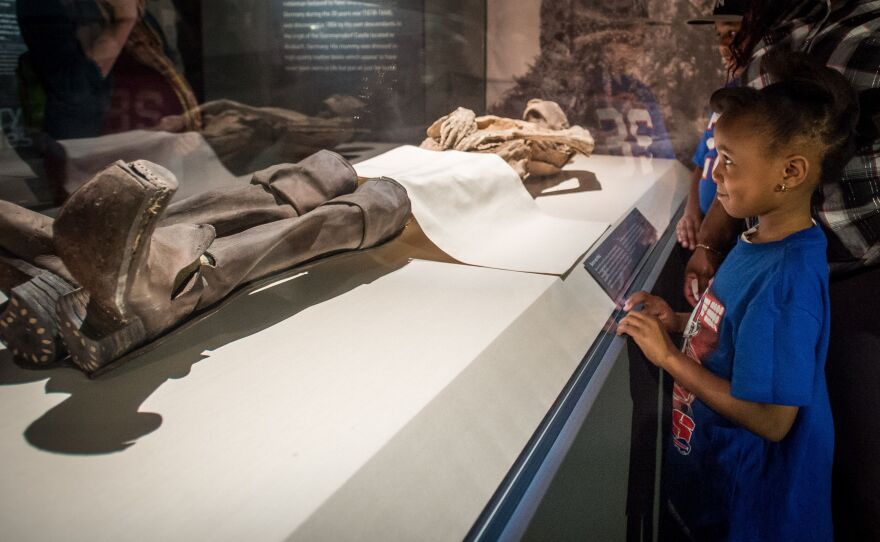In the early 19th century, a tuberculosis outbreak that struck their town of Vac, in Hungary, took the lives of Michael Orlovits, and his wife, Veronica; their infant son, Johannes, also died during that time. All three were interred in a crypt in a church, and then – along with hundreds of other bodies there – they were forgotten about for nearly two centuries.
"Mummies of The World: The Exhibition" opens Sat., Oct. 5. Carnegie Science Center, 1 Allegheny Ave., North Side.
In 1994, a renovation of the historic church uncovered the crypt, said Kathy Leacock, director of collections at the Buffalo Museum of Science. Researchers were called in. But where they might have expected to find piles of bones was something else instead: Owing partly to an unplanned, constant air flow in the crypt over the decades, many of the bodies had not decomposed, but rather dried out and mummified.
The three Orlovits mummies are among the remains of 40 humans and animals featured in “Mummies of the World,” a touring exhibition that opens Saturday in Pittsburgh.
Leacock, a co-curator of the exhibition, said a key misconception about mummies is that they all come from ancient Egypt. But while Egypt’s famous wrapped mummies are represented in “Mummies,” one goal of the exhibit is to show that mummies have existed all over the globe for millennia.

Mummification can be either “artificial” – as in the laborious, resource-intensive Egyptian process – or “natural," occurring because of a fortunate set of environmental conditions.
Along with the Orlovits family, for instance, the exhibit includes the 17th-century mummy of Baron Von Holz, of Germany; a bog mummy from the Netherlands; several mummies from Peru; anatomical mummies from late 19th-century Scotland; shrunken heads from South America; a mummified Egyptian cat; and even a contemporary mummy, created by University of Maryland researchers in 1994 using ancient Egyptian techniques.
The exhibited objects, including some 85 artifacts related to the mummies, come from an international group of 13 lenders, including the Hungarian Natural History Museum, the San Diego Museum of Man, and the Houston Museum of Natural Science.
The exhibit is a science show partly in that all the remains are part of ongoing research projects, said Leacock. For instance, noninvasive scanning techniques have allowed researchers to learn more about a millennia-old Peruvian child from the Buffalo Museum of Science whose body is mummified in a fetal position.
“Now we know it’s a girl, so that was very exciting,” said Leacock. “And also the scan showed there’s an amulet or some sort of mass up in her shoulder.”
The Orlovits mummies have been used for research about tuberculosis and its spread, she said.
But Leacock adds that another purpose of the show is to inspire audiences to think about the beliefs and customs surrounding death.
The mummies, “are individuals,” she said. “They were living and breathing. They had mothers and fathers and ancestors. So it’s just a really amazing place to have those conversations about death and dying, that come to us all.”
With subdued lighting and a policy prohibiting photos and cell phones, exhibit organizers hope to encourage visitors to treat the remains with due reverence, she said. Likewise the partial bodies: Some remains are incomplete, in some cases due to looters who accessed the mummies before researchers did.
Little is known of the identities of most of the mummified individuals. Exceptions include the Orlovits family, whose lives were well documented in church records. Michael was a miller who had sustained leg injuries perhaps related to his profession. He was second husband to Veronica, who’d been widowed before age 26, Leacock said. None of her children made it to adulthood, and Veronica herself suffered from deformation of her lower limbs; she died at 36. The baby, Johannes, appears to have been healthy – he remains chubby, in a mummyish way – and researchers believe his death at 18 months of age came quickly, from dysentery.
The three Orlovitses are clothed, in outfits reproduced based on historical analysis of the decayed textiles in which they were found.
The Science Center’s web site will have a downloadable booklet for helping parents talk to their kids about mummies, death and dying. But while some might find the sight of real-life mummies (as opposed to the movie kind) disturbing, Leacock dismisses the suggestion that the exhibit might seem creepy.
“There’s a reverence to it,” she said. “There’s a lot of content here, and a lot of science, and you have to understand how much we can learn from these individuals.
WESA receives funding from Carnegie Science Center.















